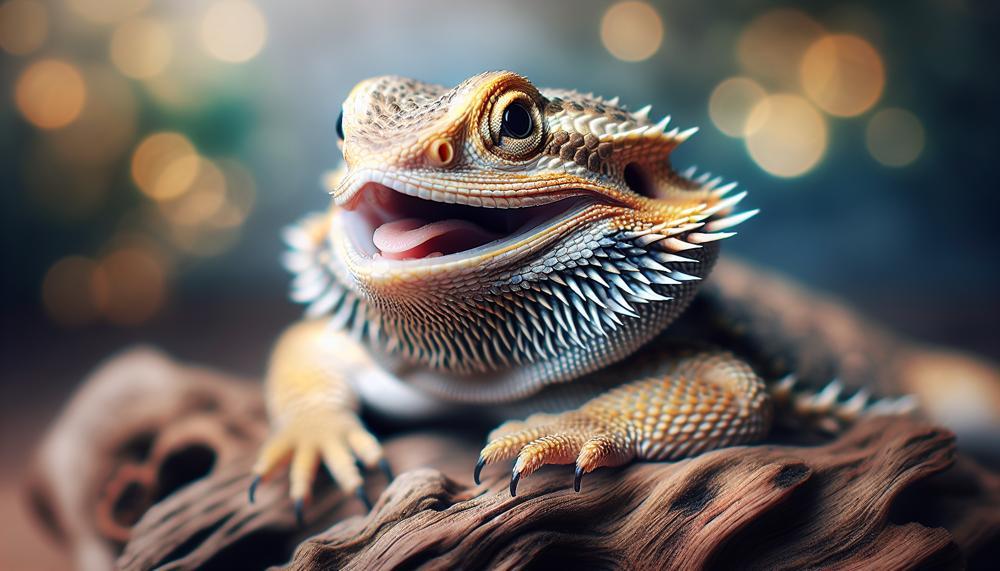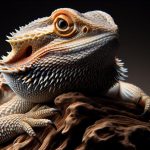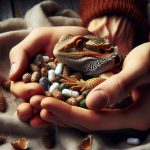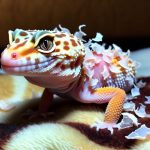Has a regular eating, sleeping, and defecating pattern
Is visible rather than hiding
Has both eyes open, which shows alertness and curiosity
Greets you, which shows confidence and comfort
Makes chirping noises, which can indicate contentment or excitement
Licks your hand if you reach towards it, which signals it’s in a good mood and okay with handling
Let’s start.
The Importance of a Happy and Healthy Bearded Dragon
Ensuring the well-being of your Bearded Dragon is essential for several reasons:
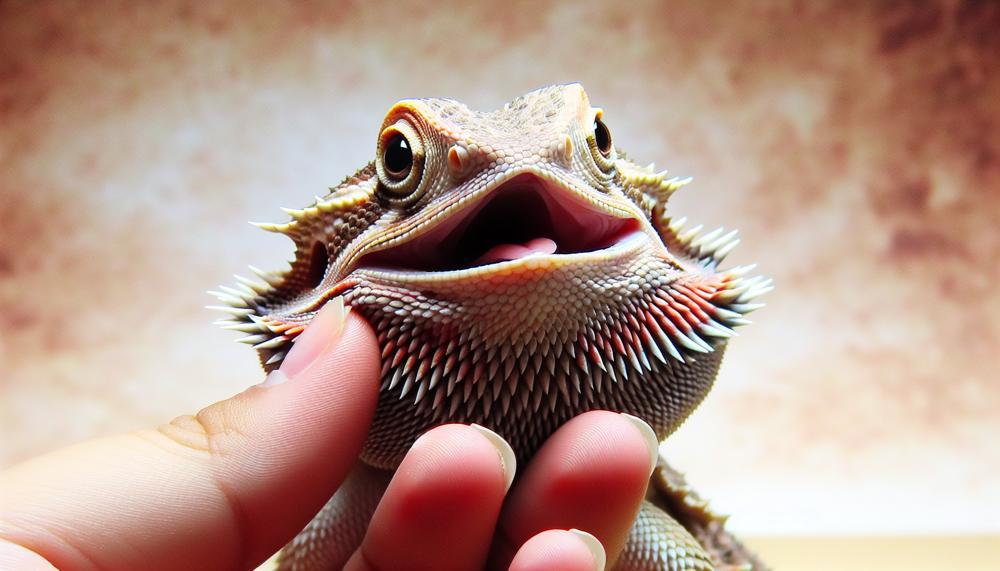
Health and Longevity
A content and vigorous Bearded Dragon will likely lead a longer, more fulfilling life.
By maintaining their health through proper diet, habitat, and regular check-ups, you can prevent common health issues and potentially extend their lifespan.
Behavioural Indicators
Their behaviour is a direct reflection of their health and happiness.
A spirited Bearded Dragon that doesn’t shy away from interaction, moves actively, and eats well is demonstrating signs of good health.
Emotional Connection
Bonding with your Bearded Dragon enriches the ownership experience.
When they exhibit trust by climbing onto you or sleeping on you, it signifies a strong bond, augmenting the joy of pet ownership.
Environmental Enrichment
A happy Bearded Dragon is an engaged one. Providing a stimulating environment with the right temperature gradients, lighting, and space for exploration is key for their contentment and mental stimulation.
Responsibility and Ethical Care
As pet owners, it’s our duty to provide the best care possible. Ensuring their happiness and health is part of responsible pet ownership and ethical treatment of animals.
Physical Signs of a Happy Bearded Dragon
Recognising the physical manifestations of contentment in your bearded dragon is key to understanding their well-being.
Bodily Language and Behaviour
| Behaviour |
Significance |
Details |
| Docile when approached |
Trust |
A beardie not scuttling away signifies they feel secure in your presence. |
| Picked up without fuss |
Comfort |
Ease in being handled shows they’re free from stress or agitation. |
| Snoozing on you |
Relaxation |
A snooze fest on their human hints at a deep sense of safety. |
| Eyes shut whilst held |
Security |
Closing their peepers in your hands means they feel protected. |
Health and Maintenance
| Aspect |
Indicator |
Observation |
| Eating and digestion |
Good Health |
Chomping down their greens and insects, with regular bowel movements, shows all’s well internally. |
| Basking |
Comfort |
Soaking up the heat lamp rays is vital for their health, avoiding it signals an issue. |
Interactive Signals
| Gesture |
Meaning |
Context |
| Head bobbing, arm-waving |
Social cues |
These quirky moves can be a social signal among beardies and also to their owners. |
| Colour brightening |
Mood/Health |
A vibrant hue can be a sign of a chipper mood, though do consider environmental influences. |
Environmental Engagement
| Activity |
Indication |
Importance |
| Exploring and climbing |
Stimulation |
Providing a playground with accessories for such activities can be a real mood booster. |
Be mindful, each dragon is an individual with their own set of quirks. Getting to grips with their usual antics is paramount to discerning their happiness.
Behavioral Cues of a Content Bearded Dragon
| Behaviour |
Description |
Indication |
| Basking |
Lying comfortably under the heat lamp |
Feeling secure and at ease |
| Exploration |
Active engagement with surroundings |
Healthy curiosity and well-being |
| Eating Habits |
Eager consumption of food |
Good health and appetite |
| Social Interaction |
Positive engagement with humans |
Trust and comfort with their owner |
| Physical Condition |
Bright eyes, full belly, healthy skin |
Overall health and contentedness |
Remember, every bearded dragon has its unique quirks, so it’s crucial to learn your own dragon’s individual ways.
Creating a Nurturing Environment for Your Bearded Dragon
Creating a nurturing environment for your bearded dragon involves a blend of proper habitat setup, diet, socialization, and health management.
Habitat Setup:
A spacious and well-structured tank is the cornerstone of your dragon’s well-being. For an adult, a minimum of a 50-gallon tank is recommended.
Ensure the tank has a variety of furnishings to mimic their natural environment, allowing them to exhibit typical behaviors such as climbing and basking.
| Item |
Detail |
Why It’s Needed |
| Substrate |
Reptile carpet, paper towels, or tiles |
Prevents accidental ingestion and supports hygiene |
| Lighting |
UVB and basking bulbs |
Crucial for digestion and simulating natural sunlight |
| Temperature |
95-105°F (basking spot), 75-85°F (cool end) |
Regulates body temperature and health |
| Humidity |
30-40% |
Supports skin shedding and respiratory health |
Diet:
A balanced diet is key to your bearded dragon’s health. Offer a mix of insects and greens dusted with calcium, alongside the occasional fruit treat.
Be vigilant with hydration, supplying fresh water daily.
Health and Socialization:
Regular health check-ups with a specialized vet are imperative. Look out for signs of good health, such as bright eyes, active demeanor, and a good appetite. Socialize your dragon through gentle handling, but respect their individual personalities to avoid stress.
Maintenance:
Keep the habitat clean with daily spot-cleaning and a thorough clean every few weeks. This prevents the spread of disease and maintains a pleasant living environment for your dragon.
Building Trust and Bonding with Your Bearded Dragon
Building a rapport with your bearded dragon hinges on patience and consistency. Here’s a step-by-step guide to foster trust and form a lasting bond with your scaly friend:
| Strategy |
Details |
Benefits |
| Quality Time |
Engage daily through handling or cohabitation. |
Builds familiarity and comfort. |
| Gentle Handling |
Support its body and move slowly. |
Increases trust and reduces fear. |
| Tasty Treats |
Offer favourites like crickets or soft fruits. |
Positive association with your presence. |
| Calm Communication |
Speak softly and consistently. |
Recognition of voice and calming effect. |
| Observation |
Monitor and understand its body language. |
Ensures a responsive and caring approach. |
Remember, like a slow dance, trust takes time to develop. Be patient, and your bearded dragon will start seeing you as a mate rather than a menace.
Common Misconceptions About Reptile Emotions
Reptiles, particularly bearded dragons, are often thought to lack the emotional range of mammals.
This myth can lead folks astray in interpreting their pet’s behavior. Here’s the scoop on some of these tall tales and what they mean for discerning if your bearded dragon is chuffed:
- Cold-Blooded Doesn’t Mean Cold-Hearted: The term ‘cold-blooded’ refers to the physiological process of thermoregulation, not a lack of emotions. Bearded dragons may not express their feelings like a dog might, but they do exhibit behaviors indicating contentment or distress.
- No Tail Wag, No Problem: Unlike dogs, bearded dragons have their own unique set of behaviors. Misjudging these actions can result in overlooking the dragon’s needs or mood.
- A Blank Stare Isn’t Indifference: Bearded dragons might not blink puppy-dog eyes at you, but they show their feelings in subtler ways, like basking contentedly or showing a relaxed posture.
| Behavior |
Common Misconception |
Actual Meaning |
| Arm Waving |
Just a quirky move |
Submission or recognition |
| Head Bobbing |
Simply getting attention |
Dominance or mating behavior |
| Glass Surfing |
Seeking attention or play |
Possible stress or need for more space |
| Color Changes |
Random occurrence |
Indicative of mood, temperature, or health |
| Digging |
Just for fun |
Could be nesting, cooling off, or stress |
To gauge a bearded dragon’s happiness, watch for a relaxed posture, active exploration, and keenness to interact. If they’re basking in the glow of their lamp or gently accepting snacks from your hand, you’re on the right track. Beware of signs like repeated glass surfing or dull colors, as they might hint at the blues.
Conclusion
In conclusion, understanding the happiness and health of your bearded dragon is paramount to their well-being and your experience as a pet owner.
The key indicators of a happy bearded dragon include relaxed body language, a healthy appetite, active exploration, and positive social interactions with you. A bearded dragon that basks contentedly, shows curiosity about their environment, and willingly engages with you is likely feeling secure and satisfied.
Clear physical signs, such as bright eyes, a full body, and healthy skin, are also telltale markers of good health. Maintaining a nurturing environment is essential, including a spacious tank with proper heat and UVB light, a balanced diet, regular veterinary check-ups, and time for social interaction.
By providing a stable, enriching habitat and engaging regularly with your bearded dragon, you can ensure a mutually enjoyable companionship with your scale-covered friend.


